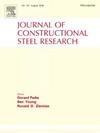极端荷载条件下 YSt 310 钢管柱的材料特性
IF 4
2区 工程技术
Q1 CONSTRUCTION & BUILDING TECHNOLOGY
引用次数: 0
摘要
钢管柱因其优异的机械性能,已成为基础设施建设中最受欢迎的解决方案之一。这些特性包括抗双轴弯曲、抗轴向压缩以及更美观的外观。YSt 310 冷弯型钢广泛应用于印度的各种基础设施项目。鉴于其广泛的应用,了解 YSt 310 在极端载荷条件下的材料特性对于设计能够承受动态、爆炸和冲击载荷的结构至关重要。本研究通过在不同应变率(从 3 × 10-4/s 到 ∼1400/s)、温度(从 27 °C 到 600 °C)和缺口半径(2、1.5 和 1 mm)条件下进行的试样测试,重点研究 YSt 310 钢的材料特性。高应变速率测试使用拉伸分裂霍普金森压力棒(TSHPB)和分裂霍普金森压力棒(SHPB)进行。对约翰逊-库克(JC)构成和损伤模型参数以及考伯-西蒙兹(CS)模型进行了评估和介绍。值得注意的是,研究提出了对 JC 模型的修改建议,以改进其预测结果,特别是在高温条件下的预测结果。研究结果与 ASME B&PV 规范第三部分中基于应变的验收标准进行了比较。实验结果表明,塑性应力对较高应变率具有正敏感性,而温度升高则会导致负敏感性。从实验中可以看出,断裂应变随着应变速率的增加而减小,温度对断裂应变的影响微乎其微。本文章由计算机程序翻译,如有差异,请以英文原文为准。
Material properties of YSt 310 steel tubular columns under extreme loading conditions
Steel tubular columns have emerged as one of the most sought-after solutions for infrastructure development due to their exceptional mechanical properties. The properties include resistance against bi-axial bending, axial compression and also better aesthetic appearance. YSt 310 cold-formed tubular sections are widely used across various Indian infrastructure projects. Given their extensive application, it is crucial to understand the material characteristics of YSt 310 under extreme loading conditions for designing structures that can withstand dynamic, blast, and impact loads. This study focuses on the material characterization of YSt 310 steel through coupon tests conducted at various strain rates (from 3 × 10−4/s to ∼1400/s), temperatures (from 27 to 600 °C), and notch radii (2, 1.5, and 1 mm). High strain rate tests are performed using tensile split Hopkinson pressure bar (TSHPB) and split Hopkinson pressure bar (SHPB). The Johnson-Cook (JC) constitutive and damage model parameters are evaluated alongside Cowper-Symonds (CS) model and presented. Notably, the study proposes modifications to the JC model to improve its predictions, specifically at elevated temperatures. The findings are compared with the strain-based acceptance criteria in ASME B&PV Code, Section III. The experimental findings revealed that the plastic stress demonstrated a positive sensitivity to higher strain rates, while an increase in temperature resulted in negative sensitivity. From the experiments, it was observed that fracture strain decreased with an increase in strain rates, and there is a marginal influence of temperature on fracture strains.
求助全文
通过发布文献求助,成功后即可免费获取论文全文。
去求助
来源期刊

Journal of Constructional Steel Research
工程技术-工程:土木
CiteScore
7.90
自引率
19.50%
发文量
550
审稿时长
46 days
期刊介绍:
The Journal of Constructional Steel Research provides an international forum for the presentation and discussion of the latest developments in structural steel research and their applications. It is aimed not only at researchers but also at those likely to be most affected by research results, i.e. designers and fabricators. Original papers of a high standard dealing with all aspects of steel research including theoretical and experimental research on elements, assemblages, connection and material properties are considered for publication.
 求助内容:
求助内容: 应助结果提醒方式:
应助结果提醒方式:


